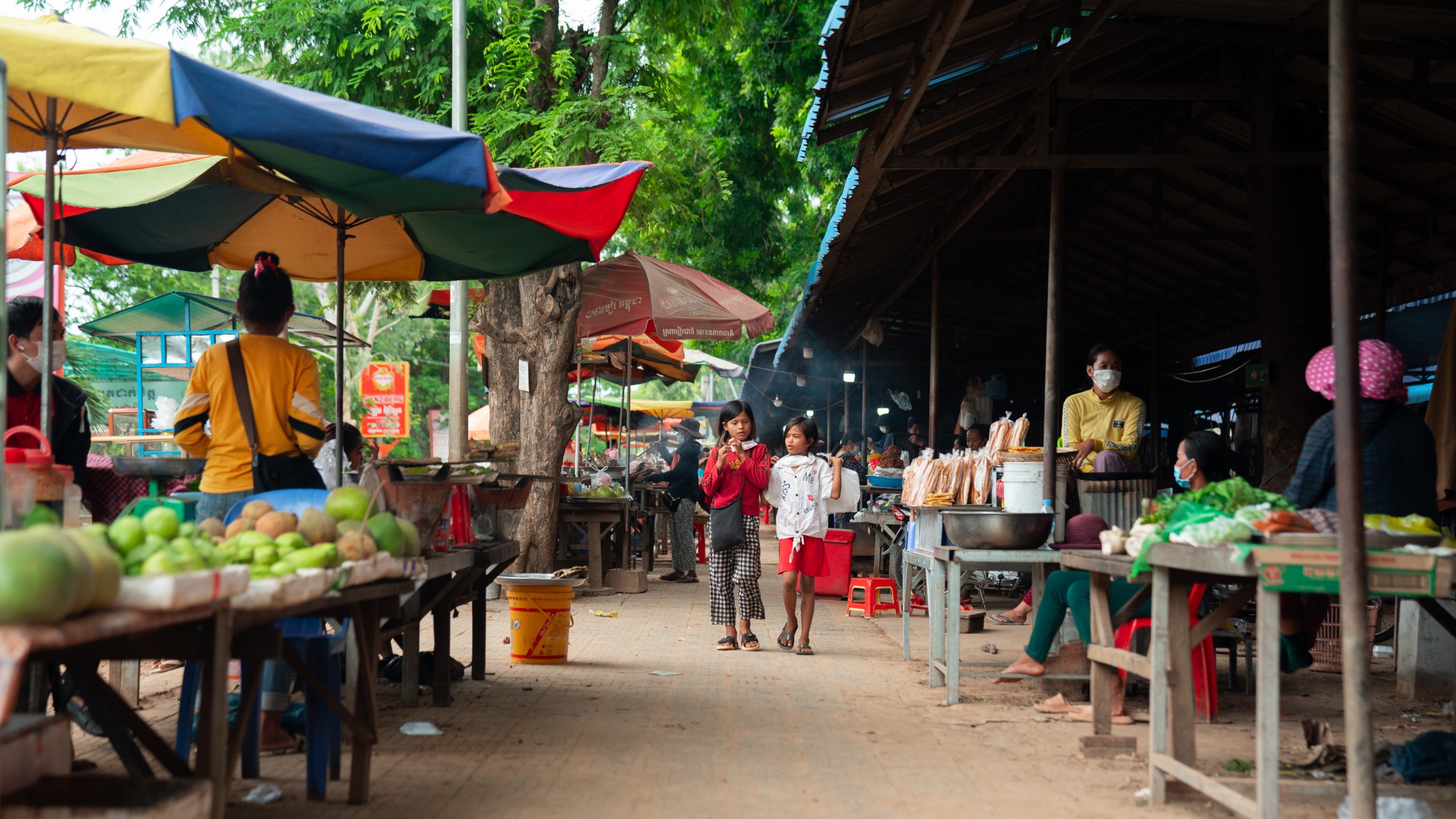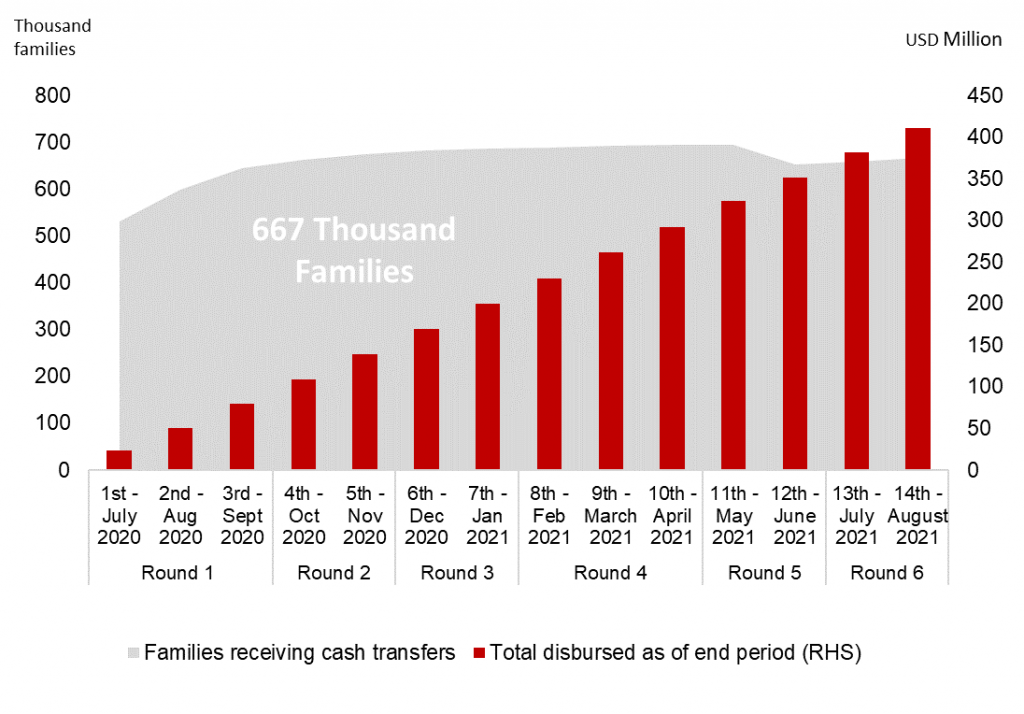By Madeleine D. Vinuya
This article was published as an op-ed in Khmer Times on November 25, 2021

In July 2020, the Cambodian government introduced a COVID-19 Cash Transfer Program to help the vulnerable and those living in poverty ease the economic impact of the pandemic. The program is a monthly cash allowance on top of the subsidies already being received by qualified households through existing social assistance schemes. The program was greatly facilitated by a database and community based identification system that targets beneficiaries—a first for the country.
Funding of the COVID-19 Cash Transfer Program was entirely through the national budget. The program was fast tracked during the crisis with targeted households receiving social support increasing from 50 to 90 percent within the first three months of implementation. As of August 2021, more than USD410 million has been disbursed to 2.6 million people.
A well-coordinated program
Cambodia’s COVID-19 Cash Transfer Program has been administered without any major hiccups. Several factors aided Cambodia in achieving a swift and well-coordinated response. First, the country had a strong fiscal position prior to the pandemic, given years of aggressive fiscal reforms. Second, the cash assistance program was developed under the National Social Protection Policy Framework, which pre-identifies beneficiaries and vulnerable groups. Third, Cambodia has a reliable online database and village-level identification system called IDPoor that enables the effective and fast disbursement of cash assistance.
The program is strongly supported by the extensive mobile money services and its initial infrastructure of the IDPoor system. Cambodia’s mobile money companies have been expanding fast, with 363 outlets per 100,000 adults in 2019, which is 15 times more than the number of ATMs in the country. This extensive network of mobile money service providers has enabled the government to deliver cash directly to households and workers in a timely and monitored manner. The funds can be withdrawn from over 7,000 money transfer outlets nationwide. About 80 percent of recipients were able to withdraw from the first day of the release of the cash transfers. Undisbursed money has been small, and is returned to the treasury for the next cycle of cash transfer.
Cambodia also has a well-functioning village-level system, which operationalizes the program’s identification and selection criteria based on a standard manual. Commune councils and the national agencies update the database regularly, allowing for immediate addition and removal of beneficiaries in the program when necessary.
Implementation Schedule and Disbursement of Cambodia’s COVID-19 Cash Transfer Program

Source: Ministry of Economy and Finance
Note: The exchange rate used is 1USD=4,000KHR. USD=United States dollar; KHR=Cambodian riel.
Survey results show that beneficiaries found the program generally effective and used the cash transfers mainly for food and other essential expenditures. Based on the frequency survey report by the World Bank in 2020, about 90 percent of the beneficiaries reported that the program had a significant positive impact on household economic well-being. Moreover, some households managed to set aside a certain amount received to open small businesses.
Following these positive outcomes, the government plans to have a mix of cash and food components for the transfers, so that beneficiaries can consume food and save cash to invest in small businesses. Overall, the authorities assess that the program has been well implemented, with only intermittent technical problems due to internet connection issues.
Key challenges
Cambodia’s COVID-19 Cash Transfer Program has been directed mainly to the rural areas, with only less than 10 percent of the IDPoor beneficiaries in urban areas. With more than 80 percent of the total workforce in the informal sector, mostly concentrated in urban areas, vulnerable urban households appear to have received less support, despite significant reductions in workers’ income during the pandemic.
As highlighted in a study in AMRO’s 2021 Annual Consultation Report on Cambodia, the program currently covers only 35 percent of the country’s poor. Since Cambodia’s pandemic situation has worsened dramatically in 2021, more households are in need of support. Thus, the Cash Transfer Program’s 2021 budget has been expanded from USD200 million to USD335 million, requiring additional drawdown from the country’s fiscal savings.
Looking ahead
With the prolonged pandemic and repeated waves of infections, a large number of migrant workers have returned to the countryside from both neighboring countries and domestic urban areas. While these displaced migrant workers have benefited from the Cash Transfer Program, the excess labor supply of migrant workers provides another policy option. The government may explore shifting its support from direct cash transfers to public infrastructure projects in rural areas utilizing the excess labor in the countryside.
Moving forward, the COVID-19 Cash Transfer Program can be gradually transformed into a conditional anti-poverty program that contributes to Cambodia’s commitment to the Sustainable Development Goals. As part of the long-term plan to unify the existing social support schemes, the integration of the cash transfer program into a family package social assistance program is already underway.
Cambodia has also made impressive progress in its vaccination drive, which will open up businesses and households’ activities. This is expected to lift the economy out of the “COVID-19 rut” sooner as emphasized by the Deputy Prime Minister and Minister of Economy and Finance Aun Pornmoniroth when discussing the country’s plan for sustainable and inclusive growth in the coming years. With economic recovery firmly underway, Cambodia can look to weaning people off the Cash Transfer Program.
